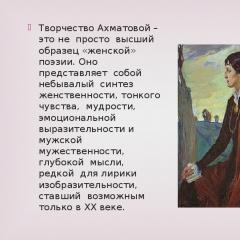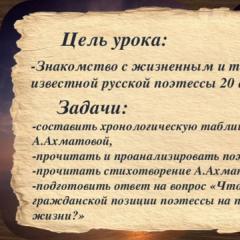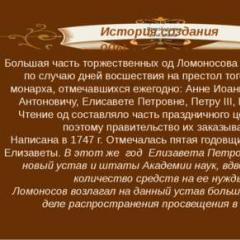Presentation on the topic of Canada in English. Canada presentation - canada




Canada is an independent federative state. It is one of the most developed countries.

It is situated on the North American continent. In size Canada is the second in the world after Russia. Its area is almost 10 million km2.

Canada is washed by the Pacific Ocean in the West, by the Atlantic Ocean in the East, and by the Arctic Ocean in the North.


Rivers Canada has three of 20 world’s largest rivers: -the St. Lawrence River, - the Mackenzie, - the Yukon.


Canada consists of 10 provinces and 3 territories.

Languages Official languages of Canada are English and French. Nearly 60 percent of the population speak English and 27 percent speak French.

Ottawa The capital of the country is Ottawa, but the largest city is Toronto.

Ottawa Ottawa is famous for its beautiful parks. It is also known as the city of bridges.

Montreal Other prominent cities are Montreal, Calgary, Quebec and Vancouver.

Niagara Falls Niagara Falls in Ontario is perhaps the first sight that people picture when thinking of Canada.

Canada is often called “the land of the maple leaf” because a maple leaf is the national symbol of the country. It became an emblem of Canada in Today the maple leaf appears on one cent coin. Red and white are Canada's official colors. These colors are the symbolic elements shown in the Canadian flag. The National Flag of Canada, well-known as “the maple leaf”, is a red 11-pointed maple leaf in the center on a white field. The beaver became the official emblem of Canada in 1975.

Flag 
- The project was done by
- Tolya Ostashkov, 10 form school 347,
- Saint - Petersburg, 2009
- (from Sea to Sea)
- The origin of the name
- Canada's name comes from the Huron-Iroquois word kanata, which means “village” or “settlement”.
- The first French settlers used the Indian name for the colony but the official name was “New France”.
- The first use of “Canada” as an official name came in 1791 when the Province of Quebec was divided into the colonies of Upper and Lower Canada.
- When the area came under the British rule in 1897, the new country was called the Dominion of Canada or simply Canada
- Canada is the second largest country in the world. It occupies the northern part of North America and a number of islands. It's total area is about 10 mln.km². It stretches from the Great Lakes in the south to the Arctic Circle in the north.
- Geographical
- position
- Geographical position
- Canada is bordered in the north by the Arctic Ocean, in the east by the Atlantic Ocean, in the south by the USA and in the west by the Pacific Ocean and Alaska.
- Provinces and Territories
- Canada is a federation of 10 provinces and 3 territories.
- There are also mountains which run parallel to Canada's east coast, in Labrador and Baffin Land. The highest peak is in the Yukon territory. It is Mount Logan.
- The maple leaf is the official emblem of Canada. The official ceremony inaugurating the new Canadian flag was held on Parliament Hill in Ottawa on February 15, 1965. The national flag consists of a white field, flanked by a red vertical field on either end, with a red maple leaf on the white field.
- National anthem
- The coat of arms
- Early settlers are represented by the three royal lions of England, the royal lion of Scotland, the harp of Ireland and the fleur-de-lis of France.
- The lion of England holds the British flag.
- The unicorn of Scotland holds the flag of Royal France.
- The bottom has the fleur-de-lis (France), the shamrock (Ireland), the thistle (Scotland), and the rose (England).
- The motto of Canada is A Mari
- Usque Ad Mare (From Sea to Sea)
- Symbols of Canada
- The beaver attained official status as an emblem of Canada March 24, 1975.
- The maple leaf began to serve as a Canadian symbol as early as 1700.
- The color of the maple leaves on the arms of Canada was changed from green to red in 1957.
- The official languages of Canada are English and French.
- The population of Canada is over 33 mln. people. Most of the inhabitants are of British and French origin. Indigenous people make up 3 per cent of the population. They include North American Indians, Metis and Inuit.
- Population
- In 1999 Canada's Inuit were given their own territory called Nunavut. (Nunavut is the Inuit word for “our land.”) It is huge but extremely cold. About 29,500 Inuit live in Nunavut today. Only 6,200 Inuit live in Iqaluit, the capital of Nunavut.
- The inukshuk is the most famous symbol of the Inuit. These marks were used to help travelers and hunters not to get lost. You can see an inukshuk on the flag of Nunavut.
- Canada is a federal state within the Commonwealth of Nations.
- Formally the head of the state is the Queen of the UK. Although the Queen holds this high position, she doesn’t rule. She serves as a symbol of British tradition. Her representative in Canada is the Governor General, whom she appoints on the advice of the Canadian Prime Minister.
- The Governor's duties are limited to symbolic, mostly ceremonial acts.
- Micha�lle Jean Governor-General of Canada
- The political system
- The real power belongs to the Prime Minister and his Cabinet. The Federal Parliament consists of the Senate, whose members are appointed by the Governor-General and the House of Commons, whose members are elected by the people for a period of five years.
- Stephan Harper Twenty-second Prime Minister of Canada
- Ottawa
- Ottawa is the federal capital of Canada. It is the seat of the federal Parliament and government.
- Toronto
- Vancouver
- Montreal
- Calgary
- Ice hockey is the national Canada's sport.
- Maple syrup festival
- Canadians favorite sweet is maple syrup. Canadians like it so much that they even have special celebrations in honor of this sweet drink. They usually start at the beginning of March and last three to six weeks. During the festival you can see sap coming from the trees and help cook syrup in a “sugarhouse”. You can listen to live music and take part in funny contests. And you can eat lots of delicious maple products.
- References
- Canadian Heritage:
- http://www.canadianheritage.gc.ca/index_e.cfm
- Canada "s Parliament: Symbols and Ceremony:
- http://www.parl.gc.ca/Information/Photos/Index-e.htm
- The Atlas of Canada:
- http://atlas.gc.ca/site/english/index.html
- Sing for canada
- http://www.singforcanada.ca/anthem.html
- Wikipedia
- http://en.wikipedia.org/wiki/Canada
- Canadian Encyclopedia
- http://www.thecanadianencyclopedia.com/
English teacher MBOU "Education Center in Ugolny Kopi Prozorova Valentina Petrovna
October 2018

Some facts about Canada
- Canada is one of the largest and richest countries in the world with a very high living standard.
- - The capital of the country is Ottawa. The state has two official languages: English and French.
- - The average length of people’s life in Canada is 81 years.
- - In 1965 the British Parliament adopted the national flag of Canada with maple leaf.
- - The state of Canada was founded on the first of July, 1867.
- - The national sport of Canada is hockey.
- - The Canadian James Naitsmith invented a basketball game to give the Canadians a chance to play this game during winter time.
- - Canadians are fond of eating cheese very much.

Canada's coat of arms
Crown on the emblem symbolizes the Canadian constitutional monarchy, headed by a king or queen. The shield represents a country where income Canadians ancestors - England, Scotland, Ireland, France, and also it's a symbol of a unified nation out of many peoples.

Flag of Canada
The red and white colors of the Canadian flag are the national colors of Canada.
Maple Leaf in the center of the flag is the national tree of Canada.

Government
- Federal parliamentary constitutional monarchy.
- Monarch - Elizabeth II
- Governor general –
- David Johnston
- Prime Minister –
- Justin trudeau
- Chief justice –
- Beverley mclachlin

Geographical position
It's the only country that is washed by the waters of three oceans: the Arctic, the Atlantic and the Pacific.
In the south Canada borders with the United States and in the north for 800 kilometers deepens the Arctic Circle.
Canada's highest point is Mount Logan.

Largest cities
Canada's largest cities are: Toronto, Montreal, Vancouver, Quebec. The capital of this state is Ottawa. This is one of the most important cultural centers in Canada, there are more than 30 museums, 50 galleries, various theaters.

Great Lakes. Superior, Michigan, Huron, Erie and Ontario.
Five Great Lakes in North America are the largest group of freshwater lakes on Earth.
Formed lake at the end the last Ice Age, when the glacier began to retreat and melting water filled valley dug by ice. Lake Superior is the largest and the deepest.

Animal world
Canada's area is covered with tundra and gave shelter to reindeer, tundra wolf, hare, polar bears, polar foxes. In the dense forests are found refuge bobcats, squirrels, hares, deer and elks.
Coastal waters are rich in fish.

Among famous Canadian celebraties are:
- Evangeline Lily, an actress. She plays the main part in the serial “To Stay Alive”

Ellen Page
Is also an actress. She is famous for the main role in the film “Juno”

Christensen
Stars in a very popular film "Star Wars"

Linda evangelista is one of the most popular top-models in the world

Arvin lavigne
and Seline dion are popular Canadian singers

Keanu reeves
is the famous Hollywood star. He played in such famous blockbusters as “Matritsa”, “Speed” and “Street Kings”.

James cameron
is also a Canadian.
He is a world famous producer and is known for his legendary film “Titanic”.

- THANKS
- Chukotka 2018
About the country Canada is a constitutional monarchy with a parliamentary system. Area 9984 thousand sq. km. (second place in the world). It is washed by the Atlantic, Pacific and Arctic oceans. It shares borders with the USA, Denmark and France. Population 34 million. The capital is Ottawa. It is a federal state with 10 provinces and 3 territories. Official languages: English and French.
Geography Canada occupies almost the entire northern half of the continent of North America and the numerous islands adjacent to it. In the east, the coast of the country is washed by the Atlantic, in the west - the Pacific, and in the north - the Arctic Ocean. The area of the country is thousands of square kilometers.

Rivers and Lakes Canada has more lakes than any other country in the world and has a significant supply of fresh water. In eastern Canada, the St. Lawrence River flows into St. Lawrence Bay, having the largest estuary in the world, where the island of Newfoundland is located. New Brunswick and Nova Scotia are separated by the Bay of Fundy, which has some of the world's highest tides. To the north of the 60th parallel there are numerous lakes (the largest of which are the Big Bear and Big Slave Lakes) and crossed by the Mackenzie River, the longest river in the country.

The Great Lakes are a system of freshwater lakes in North America, the United States and Canada. It includes a number of large and medium-sized water bodies connected by rivers and straits. The Great Lakes proper include the five largest: Upper, Huron, Michigan, Erie and Ontario. Great Lakes

Niagara Falls is the common name for three waterfalls on the Niagara River, which separates the US state of New York from the Canadian province of Ontario. Niagara Falls are Horseshoe Falls, sometimes also called Canadian Falls, American Falls and Fata Falls. Niagara Falls is the most powerful in North America. The waterfalls are 53 meters high. The foot of the American Falls is obscured by a pile of stones, which is why its apparent height is only 21 meters. The width of the American Falls is 323 meters, the Horseshoe Falls is 792 meters. Niagara Falls

Flora Northern Canada is covered with tundra, which extends far to the south. Heathers, sedges, shrubby birch and willow grow here. To the south of the tundra there is a wide strip of forests. Coniferous forests predominate; the main species are black spruce in the east and white spruce in the west, pine, larch, thuja, and others. Forests in the Great Lakes region are especially diverse (American elm, Weymouth pine, Canadian zuga, oak, chestnut, beech). On the Pacific coast there are coniferous forests of Douglas, Sitka spruce, Alaskan and red cedar); Strawberry and Oregon oak are found near Vancouver. In the coastal Atlantic provinces, Acadian forests with balsamic fir, black and red spruce; also cedar, American larch, yellow birch, beech.

Fauna Reindeer, polar hare, arctic fox and original musk ox are found in the tundra zone. To the south, the fauna is more diverse: forest caribou, red deer wapiti, elk, bighorn sheep and bighorn sheep in mountainous regions. Rodents are quite numerous: the Canadian chikari squirrel, chipmunk, American flying squirrel, beaver, jerboa jumper, muskrat, needle-fur porcupine, meadow and American hare, pika. Among the feline predators for Canada are the Canadian lynx and the puma. There are wolves, foxes, a gray grizzly bear, a striped raccoon. Weasel sable, pecan, otter, wolverine, etc. There are many nesting migratory birds and game birds. The fauna of reptiles and amphibians is not rich. There are many fish in freshwater bodies.

State and political structure Canada is a state of the British Commonwealth, and formally the head of state is the English queen. The Queen's official representative in Canada is the Governor General. Canada is a parliamentary federal system with a democratic tradition. The legislative branch is represented by Parliament. Executive power is exercised by Her Majesty's Government by the Privy Council. The Queen is the supreme bearer of executive power. The judiciary in the country belongs to the Queen and the Royal Courts.

Population Canada is relatively sparsely populated. The population density (about 3.5 people per 1 km²) is one of the lowest in the world. The population of Canada is about 34 million people. The most populated area of the country is the Quebec-Windsor corridor along the flat banks of the St. Lawrence River and in the southeast of the Great Lakes. The bulk of the population are descendants of immigrants from Europe: Anglo-Saxons, French-Canadians, Germans, Italians, Ukrainians, Dutch, etc. The indigenous population - Indians and Eskimos - were pushed northward during colonization.

Major cities Toronto is the largest city in Canada, located at the intersection of water and land routes. Population, thousand inhabitants. The cities of Toronto, Brampton, Mississauga, Markham and others form the metropolitan area of Greater Toronto (GTA) with a population of 5715 thousand. About 1/3 of the population of Canada lives in Toronto and the surrounding area. Montreal is the oldest city in the country and the largest city in the province of Quebec with a population of 1,812,800. The city is inhabited mainly by French-Canadians, therefore the city is called "French Canada" or "Paris of North America". Montreal is the industrial center of the country as well as its huge transportation hub. Montreal is a major river port. Vancouver is located in southwestern Canada, bordering the United States. The population of the city itself is people. (2006), but in Greater Vancouver, if you take into account more than 20 suburbs, more than 2 million people live. Vancouver is the largest port on the west coast of Canada and one of the largest business and industrial centers in the world.

Ottawa Ottawa is the capital of Canada. Ottawa is the fourth largest city in the country and ranks 6th in terms of living standards in the world. Ottawa is located on the banks of the Ottawa River and on the Rideau Canal. The city was founded in the 1820s. Until 1855 it was called Bytown. Since 1867 the capital of Canada. Population 875 thousand inhabitants. City administration is carried out by the municipal council headed by the mayor. The appearance of Ottawa is characterized by an abundance of water and greenery, a chess system of streets associated with a developed system of park roads. Residential buildings are mainly two-storey.

Culture Many elements of Canadian culture are very similar to that of the United States, including film, television, clothing, housing, private transportation, consumer goods, and food. Despite this, Canada has its own unique culture. To commemorate Canada's populated with peoples of diverse origins, the country has had a policy of multiculturalism since the 1960s. Elements from cultures around the world can be found in Canadian cities; festivals dedicated to the cultures of different countries are regularly held. The influence of the indigenous population of Canada is also noticeable: in many places you can find huge totem poles and other objects of indigenous art.




